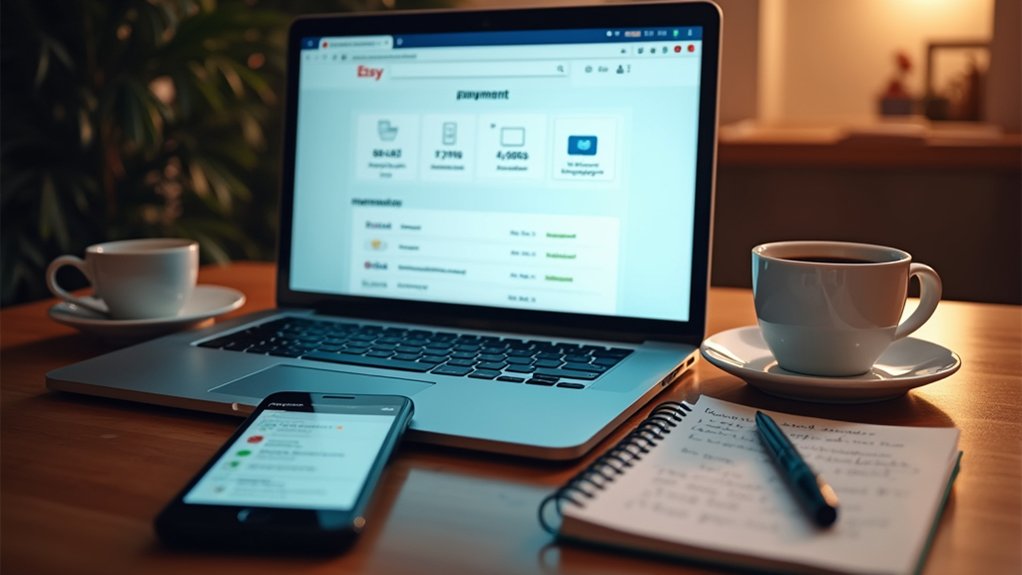Etsy sellers receive payments through Etsy Payments, which facilitates transactions with credit cards, PayPal, and digital wallets. Setting up involves inputting bank details, completing identity verification, and linking third-party accounts like Payoneer. Payments are processed bi-monthly, on the 1st and 16th, with options for daily, weekly, or monthly deposits. Monitoring balance and fees is essential for smooth operations. Those seeking enhanced transactional insight can explore further into the intricacies of Etsy’s payment process.
Key Takeaways
- Sellers must set up Etsy Payments via Shop Manager with accurate bank details and identity verification.
- Etsy Payments supports various methods, including credit cards, PayPal, Apple Pay, and more.
- Funds are deposited into the seller’s bank or Payoneer account after fees are deducted.
- Payment schedules include options like daily, weekly, biweekly, or monthly deposits.
- A minimum balance of $35 is required for withdrawal, and sales are processed bi-monthly.
Setting Up Your Etsy Payment Account
Setting up an Etsy payment account is an important step in guaranteeing a seamless financial experience on the platform.
The process begins by logging into your Etsy account and finding your way to the Shop Manager. Under the Finances tab, select Payment settings to initiate your setup.
Log into your Etsy account, navigate to Shop Manager, and select Payment settings under Finances to start setup.
Here, providing accurate bank account details and credit/debit card information is vital for smooth payment processing. Identity verification is mandatory; sellers may need to upload government-issued IDs to verify their identity and enhance marketplace security.
Etsy Payments offers flexibility in deposit frequency, whether daily, weekly, biweekly, or monthly, based on eligibility. In select countries, linking a Payoneer account is necessary to receive payments.
Confirm you meet all requirements to be eligible for Etsy Payments, streamlining your entrepreneurial journey.
Understanding Etsy’s Payment Methods
After successfully setting up the payment account, understanding the available payment methods on Etsy becomes the next step for a seller looking to optimize their business operations.
Etsy Payments is a versatile system allowing sellers to accept credit card transactions and other payment methods like PayPal, Apple Pay, Google Pay, and Etsy Gift Cards. This flexibility enhances the buyer’s experience, while sellers can manage these options via the Shop Manager.
Funds from sales are typically deposited into the seller’s bank or Payoneer account in local currency. Etsy deducts transaction fees and processing fees from each sale before depositing the funds.
Sellers can choose their deposit frequency, tailoring it to their financial needs, and must maintain accurate account details to guarantee smooth transactions.
The Role of Identity Verification in Etsy Payments
Identity verification serves as a cornerstone in securing Etsy Payments, requiring sellers to submit valid government-issued identification such as a driving license or passport to participate.
The timeline for this process might vary, but Etsy guarantees swift handling to facilitate seller access to payment capabilities.
In cases where initial verification encounters issues, Etsy proactively seeks additional information to resolve any discrepancies, maintaining a robust defense against fraud.
Verification Document Requirements
Why is identity verification so important in the world of Etsy payments? Confirming the authenticity of a seller’s identity is essential for maintaining the integrity of the marketplace.
For those enrolling in Etsy Payments, identity verification acts as a safeguard against fraud and compliance breaches. Sellers must provide certain required documents, primarily government-issued IDs like a driving license or passport.
Here’s what sellers need to know:
- Etsy Payments: Mandatory identity verification guarantees access and prevents account limitations.
- Required Documents: Government-issued IDs confirm the seller’s identity.
- Payoneer Users: Additional verification is needed for compliance with payment processing regulations.
- Verification Failure: Etsy may request further documentation to rectify any issues and complete the process efficiently.
This process is critical for uninterrupted payment processing, safeguarding both sellers and buyers.
Verification Process Timeline
How does the timeline of identity verification impact sellers on Etsy? The verification process is essential for sellers enrolling in Etsy Payments, enhancing seller protection and marketplace security.
Typically, this process takes less than 5 business days. Sellers are required to provide government-issued identification, such as a passport or driving license, to facilitate smooth payment processing.
For business accounts using Payoneer, identity verification through Etsy is mandatory to guarantee compliance with regulations. Successfully completing this verification is vital for maintaining uninterrupted selling privileges.
Although the timeline is generally swift, additional information may be requested if initial attempts encounter issues. Consequently, the timeline guarantees sellers can focus on their entrepreneurial endeavors without unnecessary delays, securing their business operations efficiently.
Verification Failure Resolution
When verification stumbles, what pathways exist for sellers to resolve the issue and maintain their Etsy Payments enrollment?
Maneuvering through identity verification challenges is essential for sellers to protect their selling privileges and guarantee seamless payment processing. Here are some strategic steps:
- Submit Additional Information: If initial verification fails, sellers should promptly provide requested documents, such as government-issued IDs.
- Regularly Update Personal Information: Accuracy in payment account details is critical; outdated or incorrect information can trigger verification issues.
- Comply with Payoneer Requirements: Business accounts using Payoneer must complete Etsy’s verification to meet regulatory standards.
- Seek Etsy Support: Engaging with Etsy’s support team can clarify verification issues, offering guidance and solutions for swift resolution.
These steps empower sellers to maintain their online business momentum without disruption.
Etsy’s structured payment schedule is designed to streamline the cash flow for sellers, with payouts occurring twice a month on the 1st and the 16th.
Understanding the timing of these payments is essential for financial planning, as processing times can extend 3 to 5 business days, dependent on weekends and holidays.
Sellers must be prepared to manage their cash reserves effectively to accommodate these intervals and guarantee their shop remains operational without disruptions.
Payment Frequency Options
For sellers maneuvering the dynamic environment of Etsy, choosing the right payment frequency is a strategic decision that can greatly impact their cash flow management.
Etsy Payments offers flexible payment frequency options, allowing sellers to tailor their cash flow to suit their business needs. Here’s how the payments work:
- Daily Deposits: Sellers can opt for daily payments, provided they maintain a minimum balance of £15 in their bank accounts, ensuring funds are available for transfer.
- Weekly Deposits: Common among sellers, weekly payments are processed every Monday, covering sales from the previous week.
- Biweekly Deposits: This option balances between frequent transfers and manageable processing time, aligning with sellers’ operational demands.
- Monthly Deposits: Ideal for those preferring fewer transfers, but requires strategic planning around business days and potential delays.
Processing Time Factors
Selecting the appropriate payment frequency is just one part of efficiently managing cash flow on Etsy; understanding the processing time factors is equally important.
Etsy Payments operates on a bi-monthly schedule, with sales between the 2nd and 15th processed on the 16th, and transactions from the 16th to month-end processed on the 1st of the following month. Payments typically require three to five business days, excluding weekends and holidays, influencing payout processing.
A minimum account balance of $35 is necessary for withdrawal, adding another layer to the strategic selection of payment options. Sellers should guarantee accurate payment information, as delays can occur if discrepancies arise.
Monitoring one’s account balance and transaction fees can preempt potential disruptions in receiving timely payments.
Managing and Updating Your Payment Information
Maneuvering the intricacies of managing and updating payment information on Etsy requires a strategic approach, especially for entrepreneurs keen on maintaining seamless cash flow.
An Etsy seller must efficiently manage their Etsy Payments account to guarantee timely transactions. Here’s how:
Effectively manage Etsy Payments to ensure seamless and timely transactions for your shop.
- Update Payment Information: Navigate to the Shop Manager, select Payment settings under the Finances tab to update bank account details or credit/debit card information.
- Identity Verification: Upload scanned images of government-issued IDs, like a driving license or passport, to facilitate identity verification and prevent transaction delays.
- Save and Confirm: After updating bank details, select “Save new details” and allow up to five business days for verification.
- Link Payoneer Payment Account: If using Payoneer, verify the Etsy payment account is linked correctly to avoid disruptions.
Attention to detail is essential to minimize transaction fees and optimize payment processes.
Resolving Payment Issues and Account Suspensions
Steering through the terrain of payment issues and account suspensions on Etsy demands a proactive and informed approach. Entrepreneurs must prioritize clear communication regarding overdue balances to excel in account management and avert suspension.
Monitoring account status regularly guarantees payments are timely, maintaining seamless operation under the Etsy Payments system. When faced with a suspension due to overdue balances, swift payment of the owed amount typically reinstates the account unless further complications arise.
Persistent payment issues can be mitigated by engaging Etsy support with pertinent order details, expediting the resolution process. This strategic interaction not only resolves existing issues but fortifies the seller’s position, enabling a smoother e-commerce experience and safeguarding against future disruptions.
Leveraging Third-Party Services for Etsy Payments
Harnessing the power of third-party services for Etsy Payments can markedly enhance the transactional experience for sellers. Etsy collaborates with providers like PayPal, Worldpay, Adyen, and Payoneer, offering diverse payment processing options that assure secure payments.
Sellers, especially in countries where Etsy Payments isn’t directly available, must register and link their Payoneer account details to facilitate transactions.
Here are key considerations:
Secure payments, seller fees, payment processing efficiency, and regulatory compliance are crucial for Etsy sellers using third-party services.
- Secure Payments: Sharing transactional information with these services guarantees compliance and security.
- Seller Fees: Be aware that transactions via third-party services might incur extra seller fees beyond Etsy’s charges.
- Payment Processing: Efficient integration with services like PayPal can streamline payment processing.
- Regulatory Compliance: Sellers should adhere to international trade laws to prevent account suspensions or transaction cancellations.
Frequently Asked Questions
How Do You Get Paid Through Etsy?
Etsy sellers receive earnings through Etsy Payments, supporting various payment methods. After transaction confirmation, Etsy deducts seller fees and processes payouts bi-monthly. Direct deposits follow the payment schedule, with troubleshooting available for payment holds or issues.
What Does Payment Processing Mean on Etsy?
Payment processing on Etsy involves handling buyer payments via various payment methods, deducting transaction fees and currency conversion costs, ensuring seller protection, managing payment disputes, and providing financial reports. Sellers receive payouts according to their verified account’s chosen schedule.
Do Etsy Sellers Get Paid Immediately?
Etsy sellers do not receive immediate payments. Instead, understanding Etsy payments involves maneuvering the Etsy payment schedule, where payment delays are explained. Sellers manage their income through direct deposit setup, considering Etsy seller fees and payment security.
How Do I Know if Etsy Paid Me?
To determine if Etsy has paid them, one must check Etsy payment notifications and payment history. Understanding the Etsy payment schedule, processing time, and methods helps avoid payment disputes or issues, as outlined in Etsy payment FAQs.
Conclusion
In traversing Etsy’s payment environment, sellers can guarantee a seamless financial experience by setting up robust accounts, comprehending diverse payment methods, and adhering to scheduled disbursements. Identity verification plays a crucial role, enhancing security and trust. Regularly managing and updating payment details minimizes disruptions, while understanding how to resolve issues and account suspensions is essential. Savvy entrepreneurs may also leverage third-party services to optimize their payment processes, ensuring a smooth and successful journey on Etsy.




